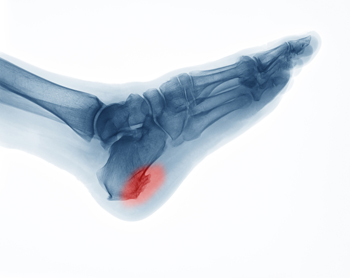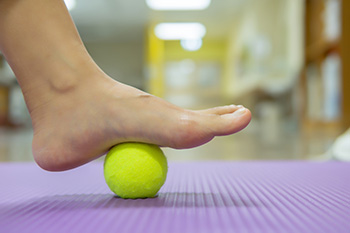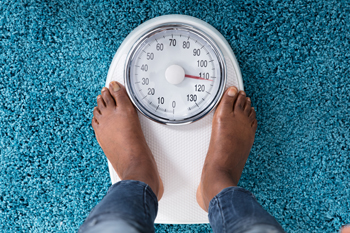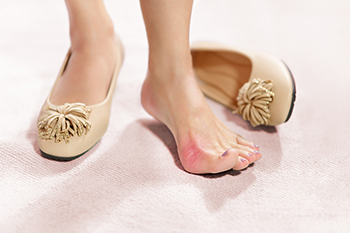Connect With Us
Blog
Items filtered by date: July 2022
What You Might Feel With Heel Spurs

Heel spurs can affect a variety of different individuals. The condition is characterized by the formation of a bony outgrowth made up of calcium deposits. This outgrowth begins at the heel and then grows toward the arch of the foot or the plantar fascia. It can be very helpful to learn about some of the common symptoms of heel spurs in case you ever develop this condition. It is important to note, however, that every patient is different and experiences different symptoms. For example, some patients with heel spurs experience no symptoms. These patients will only discover that they have heel spurs after undergoing an X-ray. Other patients can experience great pain with heel spurs. Specifically, some people may experience a sharp, shooting pain in the heel area at the beginning of the day when first putting weight on their feet. A muddled pain in the heel can also be felt throughout the day. Some people with heel spurs might even experience a kind of heat coming from the affected heel in some cases. If you have heel spurs, you might experience some kind of inflammation and swelling as well. Symptoms of heel spurs are highly specific to each patient, so reach out to a podiatrist who can help with your specific case.
Heel spurs can be incredibly painful and sometimes may make you unable to participate in physical activities. To get medical care for your heel spurs, contact Philip K. Schrumpf, DPM from Active Feet Clinic. Our doctor will do everything possible to treat your condition.
Heels Spurs
Heel spurs are formed by calcium deposits on the back of the foot where the heel is. This can also be caused by small fragments of bone breaking off one section of the foot, attaching onto the back of the foot. Heel spurs can also be bone growth on the back of the foot and may grow in the direction of the arch of the foot.
Older individuals usually suffer from heel spurs and pain sometimes intensifies with age. One of the main condition's spurs are related to is plantar fasciitis.
Pain
The pain associated with spurs is often because of weight placed on the feet. When someone is walking, their entire weight is concentrated on the feet. Bone spurs then have the tendency to affect other bones and tissues around the foot. As the pain continues, the feet will become tender and sensitive over time.
Treatments
There are many ways to treat heel spurs. If one is suffering from heel spurs in conjunction with pain, there are several methods for healing. Medication, surgery, and herbal care are some options.
If you have any questions feel free to contact our office located in Missoula, MT . We offer the latest in diagnostic and treatment technology to meet your needs.
Methods to Exercise the Feet

The feet carry the weight of the body, and provide the foundation for positive physical and mental health. If the feet are weak, and range of motion is limited, the joints and muscles in the foot may compensate. This can result in foot pain. This can cause an increased risk in falling, and it is helpful for several reasons to maintain foot strength. Additionally, the ankles may work harder than they should to keep the body moving. An effective foot stretch is called the “folded blanket walk.” This is done by placing a blanket on the floor, and beginning to walk on it. This can be beneficial in promoting balance and flexibility. Additionally, a popular foot stretch consists of rolling the sole of the foot from the top to the bottom on a tennis ball while sitting in a chair. This is beneficial in keeping the arch of the foot strong. Toe lifts are done to strengthen the toes, and they are practiced by sitting in a chair, and lifting each toe individually. There are many different types of foot exercises that can be done daily, and if you would like more information about the benefits and how to perform them, please consult with a podiatrist.
Exercising your feet regularly with the proper foot wear is a great way to prevent injuries and build strength. If you have any concerns about your feet, contact Philip K. Schrumpf, DPM from Active Feet Clinic. Our doctor can provide the care you need to keep you pain-free and on your feet.
Exercise for Your Feet
Exercise for your feet can help you gain strength, mobility and flexibility in your feet. They say that strengthening your feet can be just as rewarding as strengthening another part of the body. Your feet are very important, and we often forget about them in our daily tasks. But it is because of our feet that are we able to get going and do what we need to. For those of us fortunate enough to not have any foot problems, it is an important gesture to take care of them to ensure good health in the long run.
Some foot health exercises can include ankle pumps, tip-toeing, toe rises, lifting off the floor doing reps and sets, and flexing the toes. It is best to speak with Our doctor to determine an appropriate regimen for your needs. Everyone’s needs and bodies are different, and the activities required to maintain strength in the feet vary from individual to individual.
Once you get into a routine of doing regular exercise, you may notice a difference in your feet and how strong they may become.
If you have any questions please feel free to contact our office located in Missoula, MT . We offer the newest diagnostic and treatment technologies for all your foot and ankle needs.
The Link Between Childhood Obesity and Flat Feet

Individuals that suffer from obesity are naturally at a higher risk of experiencing a variety of foot ailments and foot pain. One important link between obesity and foot health that every parent should be aware of is the relationship between childhood obesity and flat feet. When an individual has flat feet, their entire soles rest flush against the ground and lack an arch. Although a flat foot does not always cause symptoms, the condition can cause foot pain and eventually contribute to back pain. Scientific studies have demonstrated that obese children were more likely to exhibit flat feet than other non-obese children. Experts have identified two potential explanations for this phenomenon. First, obese children may simply have more fat padding on the bottoms of their feet. And second, obese children may have sunken arches because of the extra weight that they exert on their feet. If your child suffers from obesity and you believe that they may be exhibiting signs of flat feet, it may be wise to contact a podiatrist. A professional will be able to help you identify any problems with your child’s feet and develop a plan to address them.
The more you weigh, the harder your feet must work to support your body. If you’re an obese individual and are concerned about your feet, contact Philip K. Schrumpf, DPM from Active Feet Clinic. Our doctor can provide the care you need to keep you pain-free and on your feet.
Obesity and Your Feet
People who are overweight are putting more pressure on their ankles, knees, and hips as well as their feet. This unfortunately can lead to variety of different issues.
Problems & Complications Stemming from Obesity
- When the body is overweight, it tries to compensate by changing the way that it moves. An obese person may lean forward and put extra weight on the wrong part of the foot. This puts unnecessary stress on the feet.
- Obese people are also more likely to develop type II diabetes which is a condition that causes a lot of foot problems. People with diabetes often don’t feel the cuts and sores that they may have on their feet, which can lead to more complicated and severe issues.
- Plantar fasciitis is another foot condition that can be caused by obesity. Plantar fasciitis is an inflammation of the tissue along the bottom of the foot, which causes pain and stiffness while walking and climbing stairs.
If you have any questions, please feel free to contact our office located in Missoula, MT . We offer the newest diagnostic and treatment technologies for all your foot care needs.
Plantar Warts Can Be Treated!
Bunions and Dancers

A bunion, hallux valgus, forms when there is a gradual change to the anatomy of the big toe leading to a deformity on the side of the toe that can be painful. This condition worsens when shoes are ill-fitting or have pointed toes that apply pressure to this toe. Dancers, especially ballet dancers (who dance in pointe shoes), are prone to this ailment but anyone can get a bunion. The main symptom of a bunion is a swollen, red area over the deformed joint of the big toe that is tender when touched. One can also experience numbness or a burning sensation if the surrounding nerves become irritated. The big toe angles in and irritation of the skin can lead to blisters or bursitis at the site of the bunion. When severe and long-standing, a bunion may cause the toes to overlap and arthritis, which causes additional pain when walking or performing activities that require one to push off with the feet. To prevent bunions, one can try to change their footwear to shoes that have more room in the toe box and that are wider, modify activities that cause pain, or wear shoe inserts or spacers. It is often recommended that dancers avoid bunion surgery until they stop dancing, as it may interfere with their ability to dance. If you have a bunion that is interfering with your life, consider seeing a podiatrist for proper diagnosis and treatment options.
If you are suffering from bunion pain, contact Philip K. Schrumpf, DPM of Active Feet Clinic. Our doctor can provide the care you need to keep you pain-free and on your feet.
What Is a Bunion?
Bunions are painful bony bumps that usually develop on the inside of the foot at the joint of the big toe. As the deformity increases over time, it may become painful to walk and wear shoes. Women are more likely to exacerbate existing bunions since they often wear tight, narrow shoes that shift their toes together. Bunion pain can be relieved by wearing wider shoes with enough room for the toes.
Causes
- Genetics – some people inherit feet that are more prone to bunion development
- Inflammatory Conditions - rheumatoid arthritis and polio may cause bunion development
Symptoms
- Redness and inflammation
- Pain and tenderness
- Callus or corns on the bump
- Restricted motion in the big toe
In order to diagnose your bunion, your podiatrist may ask about your medical history, symptoms, and general health. Your doctor might also order an x-ray to take a closer look at your feet. Nonsurgical treatment options include orthotics, padding, icing, changes in footwear, and medication. If nonsurgical treatments don’t alleviate your bunion pain, surgery may be necessary.
If you have any questions, please feel free to contact our office located in Missoula, MT . We offer the newest diagnostic and treatment technologies for all your foot care needs.
Blog Archives
- August 2024
- July 2024
- June 2024
- May 2024
- April 2024
- March 2024
- February 2024
- January 2024
- December 2023
- November 2023
- October 2023
- September 2023
- August 2023
- July 2023
- June 2023
- May 2023
- April 2023
- March 2023
- February 2023
- January 2023
- December 2022
- November 2022
- October 2022
- September 2022
- August 2022
- July 2022
- June 2022
- May 2022
- April 2022
- March 2022
- February 2022
- January 2022
- December 2021
- November 2021
- October 2021
- September 2021
- August 2021
- July 2021
- June 2021
- May 2021
- April 2021
- March 2021
- February 2021
- January 2021
- December 2020
- November 2020
- October 2020
- September 2020
- August 2020
- July 2020
- June 2020
- May 2020
- April 2020
- March 2020
- February 2020
- January 2020
- December 2019
- November 2019
- October 2019
- September 2019
- August 2019
- July 2019
- June 2019
- May 2019
- April 2019
- March 2019

